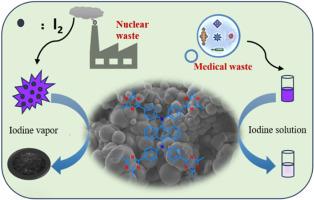一种新型的蒽基支架三嗪基多孔有机聚合物,用于气相和液相中碘的有效捕获
IF 4.7
3区 材料科学
Q1 CHEMISTRY, APPLIED
引用次数: 0
摘要
核事故条件下气态碘(I2、有机碘)的不受控制的释放日益造成严重的区域生态灾害,迫切需要开发用于核废料处理的高效碘吸附剂。本研究通过Friedel-Crafts烷基化反应,设计并合成了一种基于蒽基支架的三嗪基多孔有机聚合物(POP-W)。该聚合物具有简单的合成、优异的环境稳定性和独特的孔隙结构特征。氮气吸附表征表明,POP-W具有介孔特性,其比表面积为307.96 m2 g−1,总孔容为0.174 cm3 g−1,吸附平均孔径为2.95 nm。在75°C的碘蒸气吸附试验中,POP-W的最大吸附量为4.29 g g−1。Langmuir模型拟合表明,正己烷溶液对碘的理论最大吸附量为509.47 mg g−1。POP-W的优异性能表明其在固定和回收核废料流中的放射性碘同位素(如129I、131I)方面具有巨大的应用潜力。本文章由计算机程序翻译,如有差异,请以英文原文为准。

A novel anthracene-scaffolded triazine-based porous organic polymer for efficient capture of iodine in gaseous and liquid phases
The uncontrolled release of gaseous iodine species (I2, organic iodides) under nuclear accident conditions is increasingly causing severe regional ecological disasters, creating an urgent need for the development of highly efficient iodine adsorbents for nuclear waste treatment. In this study, we designed and synthesized an anthracene-scaffolded triazine-based porous organic polymer (POP-W) via Friedel-Crafts alkylation reaction. This polymer exhibits a straightforward synthesis, outstanding environmental stability, and distinctive pore structure characteristics. Nitrogen sorption characterization revealed that POP-W possesses mesoporous characteristics, exhibiting a Brunauer-Emmett-Teller (BET) specific surface area of 307.96 m2 g−1, a total pore volume of 0.174 cm3 g−1, and a Barrett-Joyner-Halenda (BJH) adsorption average pore diameter of 2.95 nm. In iodine vapor adsorption tests at 75 °C, POP-W achieved a maximum uptake capacity of 4.29 g g−1. Furthermore, Langmuir model fitting indicated a Theoretical maximum adsorption capacity of 509.47 mg g−1 for iodine in n-hexane solution. The outstanding performance of POP-W demonstrates significant potential for application in the immobilizati0on and recovery of radioactive iodine isotopes (e.g., 129I, 131I) from nuclear waste streams.
求助全文
通过发布文献求助,成功后即可免费获取论文全文。
去求助
来源期刊

Microporous and Mesoporous Materials
化学-材料科学:综合
CiteScore
10.70
自引率
5.80%
发文量
649
审稿时长
26 days
期刊介绍:
Microporous and Mesoporous Materials covers novel and significant aspects of porous solids classified as either microporous (pore size up to 2 nm) or mesoporous (pore size 2 to 50 nm). The porosity should have a specific impact on the material properties or application. Typical examples are zeolites and zeolite-like materials, pillared materials, clathrasils and clathrates, carbon molecular sieves, ordered mesoporous materials, organic/inorganic porous hybrid materials, or porous metal oxides. Both natural and synthetic porous materials are within the scope of the journal.
Topics which are particularly of interest include:
All aspects of natural microporous and mesoporous solids
The synthesis of crystalline or amorphous porous materials
The physico-chemical characterization of microporous and mesoporous solids, especially spectroscopic and microscopic
The modification of microporous and mesoporous solids, for example by ion exchange or solid-state reactions
All topics related to diffusion of mobile species in the pores of microporous and mesoporous materials
Adsorption (and other separation techniques) using microporous or mesoporous adsorbents
Catalysis by microporous and mesoporous materials
Host/guest interactions
Theoretical chemistry and modelling of host/guest interactions
All topics related to the application of microporous and mesoporous materials in industrial catalysis, separation technology, environmental protection, electrochemistry, membranes, sensors, optical devices, etc.
 求助内容:
求助内容: 应助结果提醒方式:
应助结果提醒方式:


